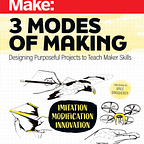Transformational Journeys; Part 2
Check out the Intro and Part 1 of this series.
When I sat down with the Human Geography teachers before this project began the question came up, as it almost always does, “What should the kids make?” My answer is always along the lines of, “How much freedom do you want to give them?” I always push for students to have more freedom to decide what the final product will be, and it’s projects like this that inevitably I sit back and say… “what exactly was I thinking?”
There are lots of articles and videos out there about how as students get older, their ability to be divergent thinkers gets worse. Ken Robinson’s famous TED talk is one of my favorite things to show high school students. Divergent thinking is a key element in creativity. It’s evident when you see something really cool and think, “how did they come up with that idea?” By the time you get to high school, you are used to a “curriculum”. You know that the kids in the grade ahead of you are going to do a particular project, and that you will do the same project next year, and it becomes easier to retread the same path that was previously created. This is why great ideas in education inevitably lose steam as they become more and more formalized year by year.
I saw it as an art teacher, the supposed place of creativity in schools. You have to do certain things each year to meet the “goals of the curriculum”. You might even show examples of past student work, which primes the pump of the following class to do the same type of work. There becomes limited opportunity to make real decisions as a student, and only room for small creative decisions.
Allowing students to make real choices with their response to a prompt maximizes everyone’s work. Students are asked to push the limits of what they think they can do; to imagine first and work out the details later. Teachers need to race to keep up with the variety of responses and different ideas that are being thrown around. You can help manage this process a little by having students work in groups as long as you think the group dynamics of your class won’t negatively affect the process, and you can limit the tools and materials that students can use. When painters use a “limited palette” they are often forced to come up with more creative solutions. But these constraints can only lessen the potential chaos, not remove it completely. Which is as it should be; real creativity is messy, non-linear, and unpredictable, but I believe that it is valuable.
Just to give you an example, here are a portion of the project being worked on so far:
- A moving windmill with a button to turn it on and turn on a light.
- A silhouette of a boy with shelves on his shoulders and objects on those shelves showing the things he had to support.
- A laser etched soccer field with 3D scanned group members showing the change in attitude of the characters by their posture.
- A road with objects representing challenges the main character overcame leading to the windmill.
- A hot air balloon with words hanging from it representing the things holding the main character back.
- A Chinese lantern with images etched into the surface.
- A soccer ball with vinyl stickers representing challenges overcome.
- A set of gears with words etched into them that work together to turn a windmill.
- A cooperative board game.
- A 3D scanned figure being pulled between architecture representing two cultures.
- This is not even close to a complete list!
So what exactly was I thinking? I was thinking about the times in my educational life (ongoing) when I had the opportunity to choose my own path and make something that was different. I always wanted to believe that I did not have to act out someones script, and at times when I did I felt intensely demotivated. I always did exactly what I needed to get the grade I wanted, but ultimately I resented the hoop jumping form of “creativity”. When I made something of my own choosing I felt good about it, even if it wasn’t the “best” thing I could have made. Looking back I recognize that feeling as empowerment. I felt like I had the power to make something that hadn’t existed before, both in form and in content.
My hope is that Makerspaces don’t get a curriculum. I hope that they are an environment where divergent thinking emerges from those students that have been otherwise squeezed into a path. A colleague of mine recently commented on how busy things have been in the BITlab and pointed out that it should get easier next year since I would be able to repeat the projects I had mapped out this year. I responded that if everything coming out of the BITlab is the same next year as it is this year, then I’m not doing my job.
Today is the second or third class period that I meet with these students. Some projects are on track to be finished, many are not and will require additional time to complete outside of class. I believe that most of the students are willing to put that time in to complete something that is their idea because they want to see their idea in the world. We’ll see if that happens!
